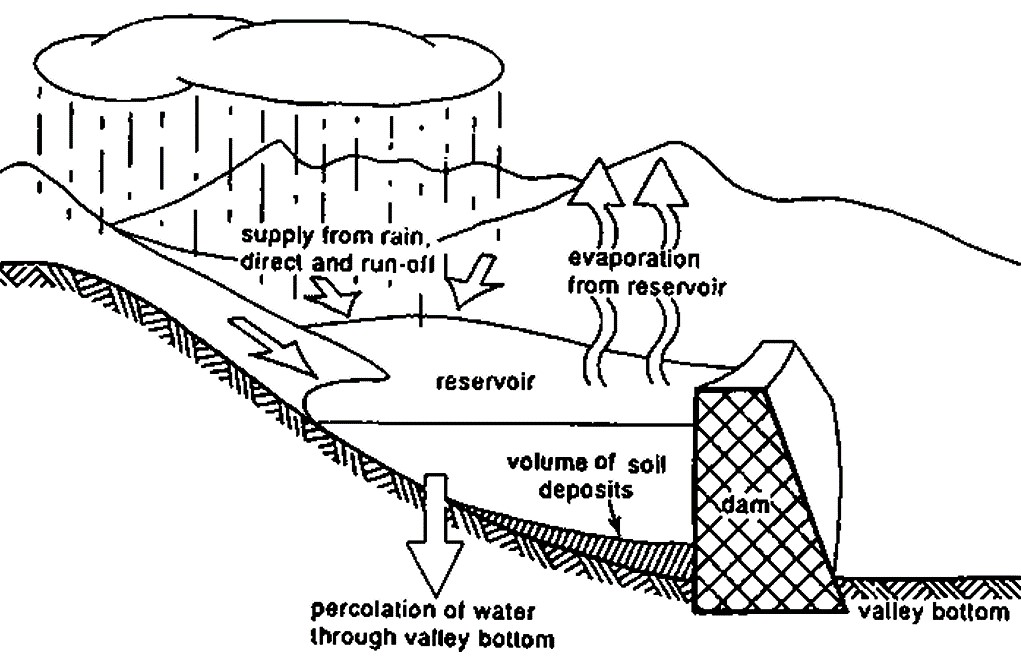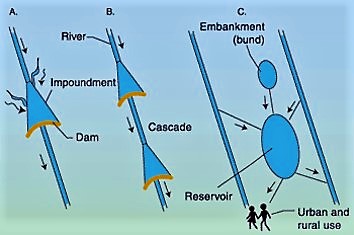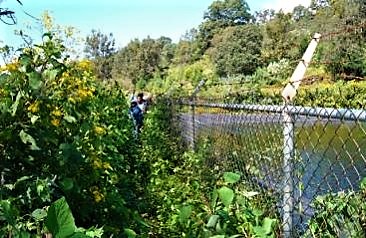How Is A Animal Made Lake Made
thirteen June 2019
Homo-made Reservoirs
Executive Summary
Man-made reservoirs, sometimes called artificial lakes, are of import water sources in many countries around the world. In dissimilarity to natural processes of lake formation, reservoirs are artificial, usually formed by constructing a dam across a riveror by diverting a part of the river flow and storingthe water in a reservoir. Upon completion of the dam, the river pools behind the dam and fills the artificially created basin (UNEP 2000). Seasonal changes of runoff and atmospheric precipitation feed the reservoir. In that location are big differences in the size of homo-fabricated reservoirs such every bit big artificial lakes or small pond-like waterbodies. The stored water can exist used for irrigation, drinking water later on purification or to produce energy.
Advantages
Quick and easy access to a water source
Creation of drinking water and h2o for other uses
Increased protection of downstream river from flooding events
Increased potential for sustained agricultural irrigation
Product of energy (hydropower)
Storage of water for utilize during low-menses periods
Increased fishery possibilities
Depending on its size it tin can get an important economic factor for a region (drinking h2o, recreation, etc.)
Disadvantages
Excessive human immigration into reservoir region, with associated social, economic and health problems
Displacement of local populations following flood of reservoir h2o basin
Displacement of local populations following inundation of reservoir water bowl
Riparian conflicts can occur peculiarly in arid areas
Dams are expensive in structure and maintenance
| In | Out |
|---|---|
| Atmospheric precipitation, Freshwater, Treated Water | Freshwater, Drinking Water, Energy |
Introduction
Factsheet Block Trunk

A reservoir is an artificial lake called human-made reservoir. Information technology tin exist formed past building a dam across a valley, past excavating the land or by surrounding a piece of country with dykes and diverting a office of the river menstruum into the reservoir. The water is stored in the reservoir and can be used for irrigation, hydro-power or as a water source for domestic or manufacture employ. Man-made reservoirs are too very effective constructions to control unexpected floods (encounter as well stormwater direction). A reservoir is fed by precipitation, rainwater runoff or from a constant flow of a river. H2o loss can occur due to evaporation (specially in arid regions) and depending on the reservoir bottom due to percolation (small reservoirs are often lined). Sediments from rivers or surface runoff can reduce the storage volume of a man-made reservoir significantly (FAO 1992).
Water stored in a valley usually has a higher level than the valley bottom downstream of the dam. Considering of this difference in level, the valley can exist irrigated by a gravity system or other distribution systems. Water can be taken from the reservoir via a physical or steel pipe. This pipe connects the reservoir to an irrigation canal downstream. A valve is unremarkably located on the upstream end of the pipe to control the belch of h2o into the canal (FAO 1992). The kinetic free energy of reservoirs is often used to produce electricity (see too hydropower small-scale and hydropower large-scale).
Ecological Impacts
Where no such h2o-torso previously existed the presence of a reservoir in a drainage bowl and the abstraction of significant water amounts for storage upstream significantly impacts the watercourse, the flora and animal, and the homo inhabitants in the drainage bowl. These potential impacts should exist identified and thoroughly examined prior to reservoir construction, in order to comprehensively appraise the total value of the reservoir project. Procedures to identify and properly evaluate potential environmental, social and economic consequences of reservoir construction involve and so-called 'Ecology Touch on Cess' (Environmental impact assessment). Such an assessment is at present obligatory past law in many countries for all new dam constructions (UNEP 2000).
Ecological impacts of reservoir dams have been reported from various aspects such as barrier for migratory animals like anadromous fish, eutrophication of reservoirs past plankton blooming, decreasing flow volumes in tail waters, stabilisation of flow regimes by flood superlative cutting, changes in thermal regimes of river water, river bed degradation and increase in substrate grain size by sediment trapping, etc. (TAKEMON 2006). Furthermore big dams and extraction of water (e.g. for spate irrigation) can create riparian conflicts (meet h2o conflicts). Also read the paragraph "Impact on Environment" in the rivers factsheet.

Basic Design Principles
Factsheet Block Torso
Adapted from UNEP (2000)

Like lakes, reservoirs range in size from pond-like to very large water-bodies (e.g. Lake Powell, United states of americaA.). The variations in type and shape, nevertheless, are much greater than for lakes. The term 'reservoir' includes several types of constructed water-bodies and/or water storage facilities:
- Valley reservoirs – created by amalgam a barrier (dam) perpendicular to a flowing river.
- Off-river storage reservoirs – created past constructing an enclosure parallel to a river, and subsequently supplying it with h2o either past gravity or by pumping from the river.
The latter reservoirs are sometimes chosen embankment or divisional reservoirs, and have controlled inflows and outflows to and from one or more rivers. In addition to single reservoirs, reservoir systems as well be, and include cascade reservoirs - consisting of a serial of reservoirs constructed along a unmarried river, and inter-basin transfer schemes – designed to movement water through a series of reservoirs, tunnels and/or canals from 1 drainage basin to another.
Pumping from a Reservoir for Irrigation
Adapted from FAO (1992)

The fields located around the reservoir upstream of a dam or surrounding a natural lake are higher than the reservoir or lake'due south water table. Here irrigation is merely possible with the assistance of pumping stations, manual or motorised pumping.
The water level in the reservoir is usually highest at the cease of the rainy season, and lowest at the cease of the dry season or the irrigation season. Pumps installed at reservoirs and lakes must be able to handle these fluctuations, which are not only vertical, but even more than pronounced horizontally, because the water recedes back to the lowest parts of the reservoir. A dead branch of a river tin can also be made to office equally a reservoir. The branch is filled with water during the wet flavor and closed off during the dry season so that the stored water may exist used. Due to the low h2o level, pumps are normally needed to irrigate fields from such a reservoir.
Costs
Factsheet Cake Body
Especially for large reservoirs costs are high. It must be designed by engineers and heavy machinery is necessary. Furthermore, costs for textile equally well every bit O&M should be considered. If it is constructed for a hydropower h2o source costs are even higher considering much more technical equipment too every bit functioning and maintenance is needed.
Functioning and Maintenance
Factsheet Block Body
Because reservoirs are man-made water-bodies, they are more amenable to artificial performance and regulation than lakes. As previously noted, operational possibilities unique to reservoirs include the ability to discharge known volumes of water at predetermined times, and selective discharge of water from different water layers inside the reservoir. This must be planned carefully equally it straight impacts the surround as described higher up. Also read the document "Reservoir Operations and Managed Flows" (WMO and GWP 2008).
Dams, peculiarly the very large ones, must exist checked regularly to ensure their stability and security. Furthermore, many man-made h2o reservoirs are affected by high sedimentation rates. The accumulation of sediments in the reservoir reduces the main reservoir nugget i.e. its volume capacity. Moreover sediments can negatively affect pumping and hydropower equipment.Therefore the designers should consider the soil erosion and sediment transport (CHANSON and JAMES 1998). In that location are several approaches to minimise or deal with sedimentation.
When a reservoir serves different functions it is about impossible to operate each function at its maximum level. For instance, a reservoir that provides irrigation, power generation (see pocket-sized calibration and big calibration hydropower), flood control, and recreational utilise may cause conflicting demands past its users (WATERENCYCLOPEDIA 2011).
Wellness Aspects
Applicability
Water from a reservoir as a surface water source is applicative for use for irrigation in agronomics, households or processing in industries. Depending on the size of the reservoir, impacts (ecological, riparian) must be considered to avoid contagion, damage of the environment or user conflicts.
Source: https://sswm.info/arctic-wash/module-4-technology/further-resources-water-sources/man-made-reservoirs
Posted by: nelsonbehateror.blogspot.com


0 Response to "How Is A Animal Made Lake Made"
Post a Comment